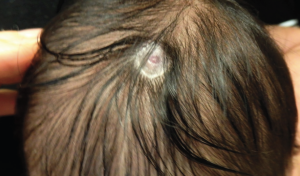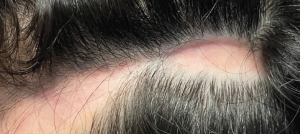Chapter 14: Hair and Nails
Localized Scarring Alopecia: Discoid Lupus
What is it?
Discoid lupus is a cutaneous form of lupus; if it affects hair-bearing sites such as the scalp it can cause scarring (permanent) hair loss. Around 10-20% of patients with discoid lupus will meet criteria for systemic lupus at some point in their life.
What does it look like?
Plaques of discoid lupus typically affect the head and neck, and less often other areas of the body. They start as scaly red plaques which eventually leave scar-like white areas centrally and hyperpigmented rims.
How is it treated?
Referral to a dermatologist is indicated for diagnostic confirmation and treatment. Mild disease can be treated topically with potent corticosteroids and/or calcineurin inhibitors. Injection of corticosteroids can help treat localized resistant lesions. The first line treatment for more severe disease is hydroxychloroquine. Conservative measures such as sun protection are also very important.
What other forms of localized scarring alopecia are there?
Acne keloidalis is a relatively common form of localized scarring alopecia. It is a variant of acne that causes bumps on the back of the scalp that scar and result in hair loss in this region. Keloid scars may form as the acne heals. It is treated with a combination of antibiotics, such as doxycycline, and intralesional steroid injections with triamcinolone acetonide (typically using concentrations of 20-40 mg/mL).
Aplasia cutis congenita is a congenital form of localized hair loss. It most commonly occurs on the scalp and is typically an isolated anomaly, although may rarely be associated with certain genetic syndromes or other congenital abnormalities. The skin is usually absent with an erosion or ulcer at birth that heals with scarring. There is sometimes a rim of thick/coarse hair around the patch of hair loss called the “hair collar sign”. If hair collar sign is present or the area of aplasia is quite large, the area should be imaged to ensure closure of the skull below the lesion.

Kerion is a severe, inflammatory form of tinea capitis and present with inflamed, boggy skin often with pustules. While most tinea capitis is non-scarring, due to the severity of inflammation, kerion can result in permanent scarring. A short course of systemic corticosteroids can be considered in addition to routing oral antifungal therapy.
Morphea, En Coup de Sabre is an autoimmune condition that can present in a linear atrophic band on the forehead and scalp. Alopecia associated with this condition is often scarring and is associated with significant atrophy. If headaches are present, patients should be referred to neurology and imaging with MRI considered,


